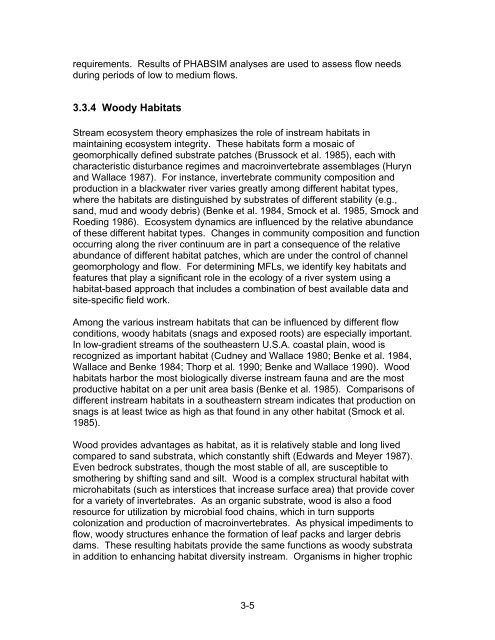Chapter 1 Minimum Flows and Levels - Southwest Florida Water ...
Chapter 1 Minimum Flows and Levels - Southwest Florida Water ...
Chapter 1 Minimum Flows and Levels - Southwest Florida Water ...
Create successful ePaper yourself
Turn your PDF publications into a flip-book with our unique Google optimized e-Paper software.
equirements. Results of PHABSIM analyses are used to assess flow needs<br />
during periods of low to medium flows.<br />
3.3.4 Woody Habitats<br />
Stream ecosystem theory emphasizes the role of instream habitats in<br />
maintaining ecosystem integrity. These habitats form a mosaic of<br />
geomorphically defined substrate patches (Brussock et al. 1985), each with<br />
characteristic disturbance regimes <strong>and</strong> macroinvertebrate assemblages (Huryn<br />
<strong>and</strong> Wallace 1987). For instance, invertebrate community composition <strong>and</strong><br />
production in a blackwater river varies greatly among different habitat types,<br />
where the habitats are distinguished by substrates of different stability (e.g.,<br />
s<strong>and</strong>, mud <strong>and</strong> woody debris) (Benke et al. 1984, Smock et al. 1985, Smock <strong>and</strong><br />
Roeding 1986). Ecosystem dynamics are influenced by the relative abundance<br />
of these different habitat types. Changes in community composition <strong>and</strong> function<br />
occurring along the river continuum are in part a consequence of the relative<br />
abundance of different habitat patches, which are under the control of channel<br />
geomorphology <strong>and</strong> flow. For determining MFLs, we identify key habitats <strong>and</strong><br />
features that play a significant role in the ecology of a river system using a<br />
habitat-based approach that includes a combination of best available data <strong>and</strong><br />
site-specific field work.<br />
Among the various instream habitats that can be influenced by different flow<br />
conditions, woody habitats (snags <strong>and</strong> exposed roots) are especially important.<br />
In low-gradient streams of the southeastern U.S.A. coastal plain, wood is<br />
recognized as important habitat (Cudney <strong>and</strong> Wallace 1980; Benke et al. 1984,<br />
Wallace <strong>and</strong> Benke 1984; Thorp et al. 1990; Benke <strong>and</strong> Wallace 1990). Wood<br />
habitats harbor the most biologically diverse instream fauna <strong>and</strong> are the most<br />
productive habitat on a per unit area basis (Benke et al. 1985). Comparisons of<br />
different instream habitats in a southeastern stream indicates that production on<br />
snags is at least twice as high as that found in any other habitat (Smock et al.<br />
1985).<br />
Wood provides advantages as habitat, as it is relatively stable <strong>and</strong> long lived<br />
compared to s<strong>and</strong> substrata, which constantly shift (Edwards <strong>and</strong> Meyer 1987).<br />
Even bedrock substrates, though the most stable of all, are susceptible to<br />
smothering by shifting s<strong>and</strong> <strong>and</strong> silt. Wood is a complex structural habitat with<br />
microhabitats (such as interstices that increase surface area) that provide cover<br />
for a variety of invertebrates. As an organic substrate, wood is also a food<br />
resource for utilization by microbial food chains, which in turn supports<br />
colonization <strong>and</strong> production of macroinvertebrates. As physical impediments to<br />
flow, woody structures enhance the formation of leaf packs <strong>and</strong> larger debris<br />
dams. These resulting habitats provide the same functions as woody substrata<br />
in addition to enhancing habitat diversity instream. Organisms in higher trophic<br />
3-5
















